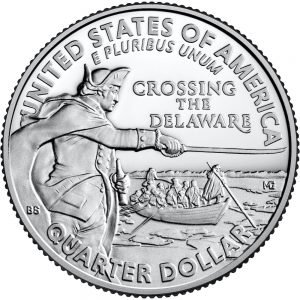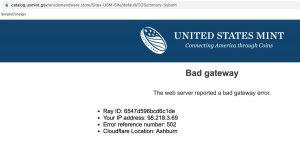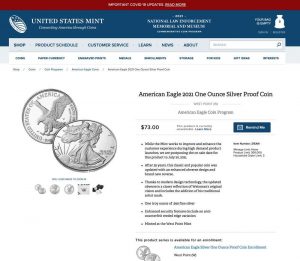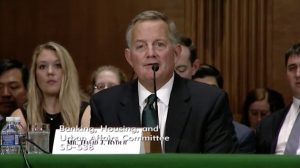WWII Memorial Commemorative Coin Bill Passes Senate
Without noticeable prompting or any other reason, the Senate Banking Committee discharged the Greatest Generation Memorial Act (S. 1596) and was passed by unanimous consent by the Senate.
If passed, the bill will require the minting of up to 50,000 $5 gold coins, 400,000 $1 silver coins, and 750,000 clad half-dollar coins in commemoration of the National World War II Memorial in Washington.
At the end of the sale, the Treasury will pay all surcharges ($35 per gold coin, $10 per silver dollar, and $5 per clad half-dollar) to the Friends of the National World War II Memorial to help maintain the memorial.
The Senate sent the bill to the House of Representatives, where it is being held at the desk because it was a bill not introduced by the majority party.
S. 1596: Greatest Generation Memorial Act
Weekly World Numismatic News for July 25, 2021
 According to reports, there continues to be a coin shortage. In areas of the country where the people primarily use cash, retailers tell news outlets that they are receiving fractions of their orders from the banks. The banks are countering that they are not receiving their complete orders from the Federal Reserve.
According to reports, there continues to be a coin shortage. In areas of the country where the people primarily use cash, retailers tell news outlets that they are receiving fractions of their orders from the banks. The banks are countering that they are not receiving their complete orders from the Federal Reserve.
The Federal Reserve Banks have not commented on the problem, but the U.S. Coin Task Force continues their Get Coins Moving promotion. When speaking on background, sources say that there are coins in the Fed’s cash rooms but that the amount they keep in reserve for emergencies is lower than usual. Some report that there is an overabundance of dollar coins if someone wants them.
While other areas of the country are experiencing coin shortages, the D.C. area does not seem to have problems. The only advertising for the Get Coins Moving program is on national telecasts. Very few businesses have signs asking for customers to spend their coins.
To see what I can find in change, I have been paying with cash for local transactions. When traveling away from home, I will use cash to test the diversity of the change I receive. While doing this in the last three months, there is a lack of diversity in the change I receive.
Even though the U.S. Mint produced more coins than it had in its history in 2020, the change I receive is full of 2019 coins and older 50 State Quarters. Over the weekend, my change had six Ohio state quarters complete with the hanging astronaut.
We are getting close to the end of July, and I have not seen a 2021 coin, including the Washington Crossing the Delaware quarter.
There is money out there. People have to spend it for it to circulate. Please spend your pocket change so I can find something interesting.
And now the news…
 → Read more at businessinsider.co.za
→ Read more at businessinsider.co.za
 → Read more at dailymail.co.uk
→ Read more at dailymail.co.uk
 → Read more at kitco.com
→ Read more at kitco.com
 → Read more at thefirstnews.com
→ Read more at thefirstnews.com
 → Read more at ekathimerini.com
→ Read more at ekathimerini.com
 → Read more at heritagedaily.com
→ Read more at heritagedaily.com
What is wrong with the U.S. Mint… this time.
In this final installment of my look at the U.S. Mint’s current problems, I will translate the expletives I wrote in the margins of my notes into an editorial about what I learned.
 The impression left by the U.S. Mint officials I spoke with is that the lawyers had more say over policy than the appointed director or the career executives. When questioned as to why the U.S. Mint did not implement additional cybersecurity measures against Internet robots, the answer was that the lawyers prevented a sound business decision.
The impression left by the U.S. Mint officials I spoke with is that the lawyers had more say over policy than the appointed director or the career executives. When questioned as to why the U.S. Mint did not implement additional cybersecurity measures against Internet robots, the answer was that the lawyers prevented a sound business decision.
I do not know why the lawyers prevented the U.S. Mint from implementing appropriate cybersecurity controls to prevent Internet robots and other abuses. Whatever the reason, it caused the U.S. Mint to violate the Federal Information Security Management Act (FISMA). Ignorance of FISMA put the U.S. Mint’s cybersecurity in jeopardy during a time when the Internet is becoming more dangerous.
When I used to work as an information security contractor for the U.S. government, including with Treasury bureaus, agencies would work in anticipation of the passage of relevant laws. When I worked for the IRS, another Treasury bureau, the lawyers and analysts would work on the implementation requirements for the new law. They drafted everything from new forms to planning for the programming necessary to implement the new law. Other agencies did the same. If the lawyers prevented the U.S. Mint from anticipating the passage of a law, then the lawyers are overanalyzing the law. It is called being pedantic.
Where was the U.S. Mint management? The lawyers are supposed to provide advice. They are not supposed to be the final answer. Even though the U.S. Mint did not have a permanent director until David Ryder was confirmed by the Senate, someone was in charge. Why is that person not held responsible for the problems?
What has David Ryder been doing since his confirmation in April 2018? During his confirmation hearing, Ryder spoke about his experience with the security of coinage. Why is he not concerned about the security of the U.S. Mint’s cyber assets?Has Ryder even worked on the security of U.S. coinage? Criminals are duping the collecting public by peddling counterfeit American Silver Eagles. Why has the U.S. Mint not implemented security features in the American Eagle program? If the security of the physical currency is Ryder’s specialty, why has he not implemented it to protect the public?
This is not Ryder’s first rodeo. He was appointed the U.S. Mint director in 1992 by President George H.W. Bush. Ryder should understand how the government works. But his performance during his current appointment and the decisions he has made have the numismatic public questioning his competence.
When someone writes a critical opinion piece, they should provide possible solutions. In this case, I am not sure that any suggestion would work. The U.S. Mint does not listen to the collecting public. When they feign interest, the people who try to be responsive move along with the political winds, and new appointees ignore the lessons of the past under the guise of “Not invented here.”
A common problem among political appointees is that they come into any job thinking they know better than career appointees. It causes them to ignore the past and rediscover previous mistakes. I spent a career fixing the security problems caused by mistakes made by appointees.
I wonder if a civilian advisory board would help the U.S. Mint? The board would consist of experts in numismatics and government processes. But it will give the bureau someone to blame if something goes wrong because if I learned nothing else from my 25 years working for the government, career executives and appointees are collectively risk-averse.
The U.S. Mint has a memory problem
This is the second article of three regarding the recent problems at the U.S. Mint.

It is as if the U.S. Mint did not learn a lot since the fiasco of the 2014 Kennedy Half Dollar 50th Anniversary Gold Coin release. (Image courtesy of ABC 7 News, Denver)
Last month, a discussion was held with a representative of the U.S. Mint’s communications department and a manufacturing supervisor to understand better the 2021 Morgan Dollar ordering failures. When asked about lessons learned from previous sales, they admitted to working at the U.S. Mint for four years or less and could not talk about previous issues.
After asking about lessons learned from the past with responses ringing like “not on my watch,” it brought to mind the first Numismatic Forum in 2016, where the only blogger in attendance asked whether the discussions would survive changes of leadership and administrations. Rhett Jeppson was nominated to be Director of the U.S. Mint but was never confirmed. Although there were three more Numismatic Forums, it is apparent that none of the discussions survived leadership changes.
Part of the problem is with the government’s Senior Executive Service (SES) program. Members of the SES are government employees hired to senior management positions within the federal government. They undergo special training in government leadership and understand how to lead their sections through policy changes. SES employees are supposed to be non-partisan government workers. There are also limited reasons for the SES to stay with the agency to build collective knowledge.
There are three ways an SES employee can be appointed. A career appointment is a merit position staffed by a qualified executive. A noncareer appointment is a temporary appointment and is subject to several restrictions, including the number of temporary appointees the government can hire. Finally, a limited appointment is hired for an 18 month to a three-year term. Rhett Jeppson’s role that made him the acting Director was the result of a limited appointment.
SES members are also encouraged to change agencies every four years. Although there are exceptions, the SES program is designed not to allow executives to become too powerful within the agencies. Forcing them to move reduces the risk of potential abuse of power.
As SES members come and go, the U.S. Mint loses the institutional knowledge they earned over the years. Experience working with members of the SES program shows that the new appointees rarely refer to documentation left by their predecessors. Their egos also have them ignoring employees and contractors with the institutional knowledge.
The U.S. Mint has resources in the numismatic community that can help teach them about the past. Having an engaged numismatic community available to help the U.S. Mint makes the bureau unique among government agencies. If their egos prevent them from reaching out to the numismatic community, the SES members can perform a web search on any topic to read what the numismatic press wrote about any issue.
During the discussion, the U.S. Mint emphasized how they wanted to work with the numismatic community and do their best to make the products accessible. While they will talk with members of the numismatic media, the U.S. Mint will not reach out for the community’s help.
The numismatic community wants the U.S. Mint to be able to support our collecting habits. They have a unique opportunity to engage a community willing to help. If the U.S. Mint wants to demonstrate that they are, they should set up a program of numismatic advisors to help them understand what went wrong in the past and how to make it better for the future.
About the U.S. Mint’s Silver Shortage
This is the first article of three regarding the recent problems at the U.S. Mint.
 Economic analysts believe there is a silver shortage but that it is not critical. According to the supply chain reports, a sufficient supply of industrial silver for manufacturers to keep up with production. The reduction in computer chip production because of COVID-based plant shutdowns is the greatest threat to manufacturing.
Economic analysts believe there is a silver shortage but that it is not critical. According to the supply chain reports, a sufficient supply of industrial silver for manufacturers to keep up with production. The reduction in computer chip production because of COVID-based plant shutdowns is the greatest threat to manufacturing.
Jewelry and other businesses that use silver for their beauty are experiencing a slowdown but not to the extent of the computer chip industry. The industry has been able to use recycled silver fueled by people cashing in their scrap silver. One silver refiner reports that they have more work than they can process.
Although manufacturers have silver to maintain production, the U.S. Mint announced on May 28, 2021, that “The global silver shortage has driven demand for many of our bullion and numismatic products to record heights.”
On June 2, the U.S. Mint clarified their statement by saying, “In a message released Friday, May 28, we made reference to a global shortage of silver. In more precise terms, the silver shortage being experienced by the United States Mint pertains only to the supply of silver blanks among suppliers to the U.S. Mint.”
Why is the U.S. Mint different from the other industries?
The short answer is that the U.S. Mint is just another government agency subject to federal law.
The U.S. Mint is required to buy silver mined in the United States within one year of its mining (31 U.S. Code §5132(a)(2)(D)). Under this law, the U.S. Mint cannot use recycled silver or silver that the government has not purchased from the mines.
The U.S. Mint discontinued assay operations shortly after the passage of the Coinage Act of 1964. Since then, the bureau has bought the metals from other manufacturers, either sheets or already formed planchets. When the American Eagle Program started, the law required the U.S. Mint to use the silver in the Strategic and Critical Materials Stockpile. The U.S. Mint manufactured the planchets in West Point.
When the program depleted the Strategic Stockpile, Congress updated the law to require the U.S. Mint to use freshly mined silver. They found that it was more cost-effective to have a commercial vendor manufacture the planchets.
Hiring a commercial vendor to do work for the federal government is different from a business-to-business transaction. The government requires all contracts and contractors to follow the Federal Acquisition Regulations (FAR) to purchase goods and services.
For the government to contract with any company, a bidding and vetting process can last from weeks to years. The agency has to produce requirements, selection criteria and evaluate the proposals, called source selection.
Congress purposely made the process challenging to promote fairness in the bidding process and ensure the government pays a fair price. Unfortunately, the process is expensive and fraught with problems.
For the U.S. Mint, the problem is that FAR does not allow the latitude to find alternate vendors when there are supply issues.
The U.S. Mint has contracts with four vendors to make silver planchets. They have vetted the contractors, their processes and have contractual quality control measures to ensure the planchets comply with the Treasury’s legal and quality requirements. If the vendors cannot fulfill the U.S. Mint’s order, the law prevents them from looking for immediate alternatives.
According to the U.S. Mint, the suppliers of silver planchets had production slowdowns because of COVID-19 operating precautions. In addition to manufacturing issues, the mining operators also experienced slowdowns because of the same operating precautions. Every industry is experiencing supply chain interruptions.
Where the U.S. Mint could have done better was to order the planchets sooner. The U.S. Mint reported that agency attorneys refused to allow their purchasers to order planchets before the law was signed. The bill, H.R. 6192, was sent to the president on December 24, 2020. The president signed the bill into law on January 5, 2021 (Public Law No. 116-286).
When a law is signed, the White House will tell the appropriate Departments. If that does not happen, the agencies receive notice from the Government Printing Office (GPO) who publishes the laws. Like everything else, the GPO has experienced interruptions because of pandemic protocols.
According to a government attorney that works for the Inspector General’s office in a non-Treasury department, agencies have the latitude to work on anticipated laws. An example cited is that the IRS works on drafting forms and regulations based on the bills in progress to be ready for the filing season.
Although Congress did not do the U.S. Mint a favor by passing the bill on Christmas Eve, the White House did not do the U.S. Mint a favor by not letting the Treasury know they signed the bill. However, the leadership of the U.S. Mint allowed the lawyers to dictate operations. The lawyers are supposed to be advisors, not the last word.
It worked… sort of!
 I was able to order the 2021-W American Silver Eagle one-ounce proof coin today with only minor issues.
I was able to order the 2021-W American Silver Eagle one-ounce proof coin today with only minor issues.
Like every other time I ordered new releases from the U.S. Mint, I logged into my account before the sale. I verified that the credit card I had registered was the correct card. The card was in front of me just in case something went wrong.
As the time closed in at noon, I tapped the refresh button. As soon as the button changed from “Remind Me” to “Add to Bag,” I began tapping.
When the page did not respond immediately, I panicked and tapped again. Of course, I should know better. But I am an anxious collector who cares what my background is. After tapping more than once, the coin appeared in my bag, and I pressed checkout.
I did not look at the contents of my bag as I scrolled down to my payment option. I selected my stored credit card then watched as it took too long to fill the form. As it took time, I was pressing buttons faster than the website responded. After the system finally filled in the form, I forgot to enter the CVV for my card. Then another tap.
Once the confirmation page appeared, I took a screenshot of the information for safekeeping. That is when I realized my nervous tapping added more than one coin to my bag. It looks like I ordered three coins. It also may explain an error I received during the tapping on the link when the system thought I was overfilling my bag.
As I type this, the coin sold out. I do not know how long it was before the coin sold out because I had to put down my iPad and go back to work. It looks like if you missed the opportunity to order, then you would have to purchase one on the secondary market.
A quick search on eBay suggests that the presale for graded coins is averaging $135-150.



